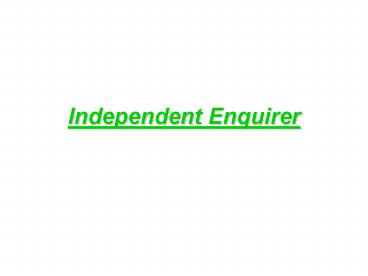Independent Enquirer - PowerPoint PPT Presentation
1 / 10
Title:
Independent Enquirer
Description:
Independent Enquirer Identify questions to answer and problems to solve. (IE1) Plan and carry out research, appreciating the consequences of decisions. – PowerPoint PPT presentation
Number of Views:50
Avg rating:3.0/5.0
Title: Independent Enquirer
1
Independent Enquirer
2
Identify questions to answer and problems to solve. (IE1)
Plan and carry out research, appreciating the consequences of decisions. (IE2)
Explore issues, events or problems from different perspectives. (IE3)
Analyse and evaluate information, judging its relevance and value (IE4)
Consider the influence of circumstances, beliefs and feelings on decisions and events (IE5)
Support conclusions using reasoned arguments and evidence (IE6)
3
KWLH Enquiry Grid
What do I Know? Would like to know? What have I Learned? How did I learn it?
- Questions that I still have
4
Double Bubble
- Think of an issue, event or problem you wish to
- investigate from different perspectives.
- Decide on perspective A and perspective B.
- Complete each bubble by noting down thoughts,
feelings, emotions - from that perspective.
- As the arrows move further away from the centre,
the greater the contrast - there is between the two perspectives in terms of
emotions, thoughts and - feelings that are being noted down.
5
PNI
All the positive points in the P section. All
the minus/negative points in the N section All
interesting points in the I Section Complete
the PNI from different perspectives.
6
Enquiry Verbs
Investigate Learn Explain
Detect Verify Disprove
Ascertain Prove hypothesise
Determine Corroborate Test
Establish Substantiate Validate
7
QuADS Grid
Question Answer Details Source
Start with a question Research some possible
answers Summarise any information
discovered Provide accurate details of research
sources
8
P
Remember to PEE!!
POINT State the point clearly, bluntly and
briefly
E
EVIDENCE put a fact (or facts) to prove what you
are saying.
E
EXPLANATION explain how what you are saying
answers the question you have been asked or
supports the conclusion you have reached
L
LINK If you are writing a number of paragraphs,
remember to include a link
9
Set up an ENQUIRY.
STAGE 1 Start with a question e.g. What would
happen if? Which was the most important?
STAGE 2 Suggest an answer even if you aren't
sure. This is your initial answer or your
hypothesis. It can be based on what you about the
topic or simply what you think is the most likely
answer to the question.
STAGE 3 Carry out the investigation to discover
the answer to your question.
STAGE 4 Revise your initial answer or hypothesis
taking into account everything that you have
found out during your investigation.
10
Internet Checklist (When carrying out an
investigation using the internet, answer these
questions to help judge the reliability of the
information)
WHERE did the author get the information from? Do
they give their sources of information? Where
else did you hear about this site?
WHO is the author providing the information? Is
it to inform, persuade, explain?
WHEN was the information created or updated? Does
it include recent information?
WHAT information is contained on the website? How
does this new information compare with what you
already know? How does it change what you know?
How in depth is the information? How true do you
think the information is?
WHO is the author or the person providing the
information? Does the author list his/her
occupation, experience, education or other
credentials?































